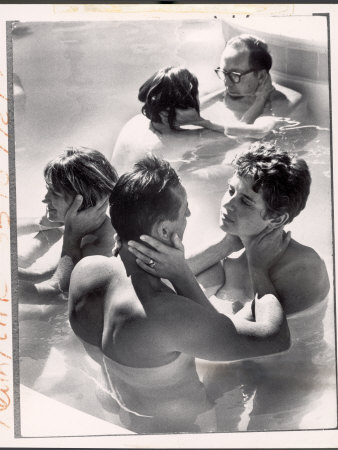What do you get when you mix LSD, nudism and psychopathy?
...More psychopathy.
In the late 60's Canadian psychiatrist Eliot Barker sought permission from the Canadian government to obtain a large batch of LSD. He then found a bunch of criminal psychopaths, lead them into a bright green room he named the 'Total Encounter Capsule' and asked them to remove their clothes and 'socialise' for 11 days.
What did the LSD-fuelled criminal psychopaths learn from the naked psychopathy session? How to be loving, empathetic or compassionate? Well, no - the group actually became better psychopaths. They worked out how to fake these feelings and 80 percent re-offended, as opposed to the usual 60 percent.
Diluting the Truth: HDR
Swedish photographer Paul Hansen won the 2013 World Press Photo of the year with an image that flirts with the limits of alteration. The photo has sparked a heated debate in cyberspace, not because it captures a funeral procession of two Palestinian children killed by a missile attack in their home late last year; but because it looks like a movie poster.
So how far is too far in a world full of digital manipulation? Do the ethics that encompass photojournalism still apply?
What bothers me about Hansen’s image isn’t its content. It's Hansen choice to dramatically alter a perfectly fine image. Hansen knew the guidelines, and he ignored them and the judges chose to ignore the obvious alterations too. But his audience disapproved. Hansen knew his image would be scrutinised. So why did he do it? Honestly, I'm not sure. The problem for me is that the image has lost a large portion of its integrity because Hansen has surgically removed it through Photoshop. What gives him the right to alter the truth? Why strip a powerful image of its honesty?
I guess in the case of this particular image I should realise that any publicity is good – right? And that more people have seen this image because of the debate it has ignited. So isn’t it a good thing Hansen’s undeniably poignant image reached such a large audience than it arguably wouldn’t have if it weren’t altered? Well, almost. It demonstrates that we, as professional image-makers, are more capable of deceiving the public than ever before. Although, what frightens me more than this is the willingness of prestigious contests like the World Press Photo awards to grant misleading images first place.
Dead, and going to die.

- Lewis Payne by Alexander Gardner, 1865.
Three photos of Lewis Payne waiting to die in his jail cell.
Payne attempted to assassinate Secretary of State William H. Seward in his home. He was also one of four people hanged for the Lincoln assassination conspiracy.
Roland Barthes cites the middle image in Camera Lucida, explaining that "...the photograph is handsome, as is the boy: that is the studium...and the punctum is: he is going to die."
This idea that the boy is handsome, but more importantly, alive, creates a paradox; because when we look at this image, he is dead - and in the image, he is waiting to die.
Dignity...
‘The photographer may think he is doing the subject a favour by presenting them in a certain way, but this approach is simply dishonest and deprives the subject of their dignity of simply being as they are...’
An interesting perspective in light of the recent announcement of the World Press Photo award winning images.
For more interesting insights check out Jack's Blog Communiqué.


